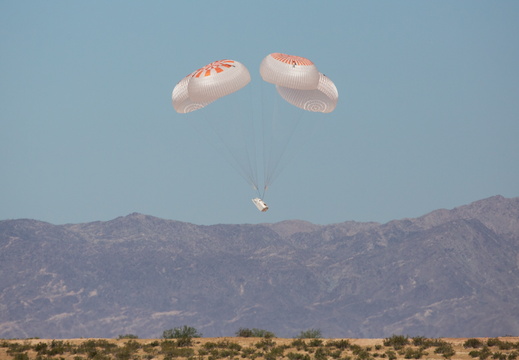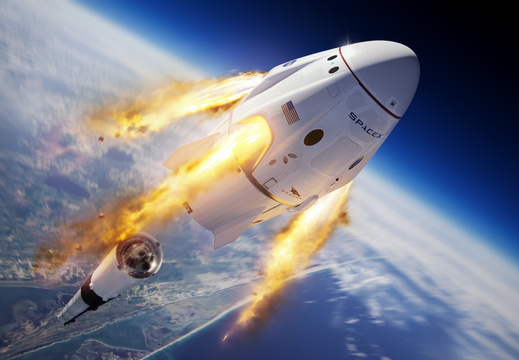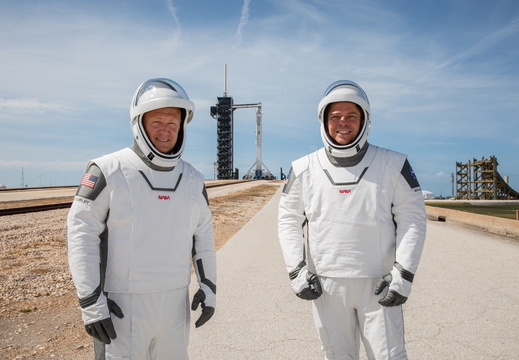
DM-2
Mission Objective
NASA's SpaceX Demo-2 (DM-2) mission was the first crewed test flight of the Crew Dragon spacecraft, marking a pivotal milestone in NASA's Commercial Crew Program. The mission aimed to validate the Crew Dragon's capabilities to safely transport astronauts to and from the International Space Station (ISS). This mission restored human spaceflight capabilities to the United States after the Space Shuttle program concluded in 2011.
All mission objectives were successfully achieved, with the Crew Dragon spacecraft demonstrating reliable performance in launch, docking, on-orbit operations, and re-entry.
Mission Highlights
Demo-2 launched from Kennedy Space Center's Launch Complex 39A on May 30, 2020, at 3:22 p.m. EDT. The Falcon 9 rocket performed nominally, and the first stage successfully landed on the drone ship *Of Course I Still Love You* in the Atlantic Ocean.
Following stage separation, the Crew Dragon capsule *Endeavour* (C206) executed a series of maneuvers to autonomously dock with the ISS's Harmony module on May 31, 2020, at approximately 10:29 a.m. EDT.
During their 64-day mission aboard the ISS, the Demo-2 astronauts conducted various tests of the Crew Dragon systems, contributed to scientific experiments, and participated in public engagement events. The mission provided valuable data on the spacecraft's performance in a real operational environment.
After completing their mission, Demo-2 undocked from the ISS on August 1, 2020, and safely splashed down in the Gulf of Mexico off the coast of Pensacola, Florida, on August 2, 2020, at 2:48 p.m. EDT. Recovery operations were executed smoothly, marking the successful conclusion of the mission.
Crew
Douglas G. Hurley, Commander (NASA)
Robert L. Behnken, Joint Operations Commander (NASA)
Payload
Crew Dragon *Endeavour* (C206)
Cargo: Limited scientific equipment and crew provisions
Prelaunch Milestones
04/01/20 – Crew Dragon *Endeavour* arrives at Kennedy Space Center
04/15/20 – Falcon 9 rocket integration complete
05/20/20 – Flight readiness review
05/27/20 – Initial launch attempt (scrubbed due to weather)
Launch
May 30, 2020; 3:22 p.m. EDT
Launch Pad 39A
Falcon 9 Block 5
Crew Dragon *Endeavour*
Firing Room 4
Orbit
Altitude: ~250 miles (ISS orbit)
Inclination: 51.6 degrees
Duration: 64 days
Distance: ~27 million miles
Landing
August 2, 2020; 2:48 p.m. EDT
Gulf of Mexico, near Pensacola, Florida
Recovery Ship: *Go Navigator* (SpaceX)
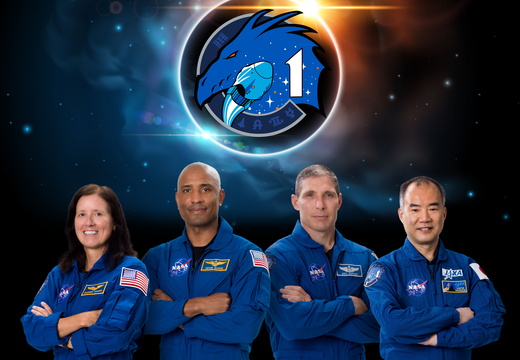
CREW-1
Mission Objective
NASA's SpaceX Crew-1 mission was the first operational flight of the Crew Dragon spacecraft as part of NASA's Commercial Crew Program. The mission aimed to transport four astronauts to the International Space Station (ISS) for a long-duration stay focused on scientific research, technology demonstrations, and international cooperation. This mission marked a significant milestone in returning human spaceflight capabilities to the United States.
All mission objectives were successfully achieved, with the Crew Dragon spacecraft demonstrating reliable performance in navigation, environmental control, and communication systems throughout the mission.
Mission Highlights
Crew-1 launched from Kennedy Space Center's Launch Complex 39A on November 15, 2020, at 7:27 p.m. EST. The Falcon 9 rocket performed nominally, and the first stage successfully landed on the drone ship *Of Course I Still Love You* in the Atlantic Ocean.
Following stage separation, the Crew Dragon capsule *Resilience* (C207) executed a series of maneuvers to autonomously dock with the ISS's Harmony module on November 16, 2020, at approximately 11:01 p.m. EST.
During their 167-day mission aboard the ISS, the Crew-1 astronauts conducted over 200 scientific experiments and technology demonstrations, contributing to advancements in biotechnology, physical sciences, and Earth observation. The crew also performed station maintenance, including hardware upgrades and system checks to ensure optimal performance.
After completing their mission, Crew-1 undocked from the ISS on May 1, 2021, and safely splashed down in the Gulf of Mexico off the coast of Panama City, Florida, on May 2, 2021, at 2:56 a.m. EDT. Recovery operations were executed smoothly, marking the successful conclusion of the mission.
Crew
Michael S. Hopkins, Commander (NASA)
Victor J. Glover, Pilot (NASA)
Shannon Walker, Mission Specialist (NASA)
Soichi Noguchi, Mission Specialist (JAXA)
Payload
Crew Dragon *Resilience* (C207)
Cargo: Scientific equipment, ISS maintenance hardware, and crew provisions
Prelaunch Milestones
10/01/20 – Crew Dragon *Resilience* arrives at Kennedy Space Center
10/15/20 – Falcon 9 rocket integration complete
10/30/20 – Flight readiness review
11/10/20 – Static fire test completed
Launch
November 15, 2020; 7:27 p.m. EST
Launch Pad 39A
Falcon 9 Block 5
Crew Dragon *Resilience*
Firing Room 4
Orbit
Altitude: ~250 miles (ISS orbit)
Inclination: 51.6 degrees
Duration: 167 days
Distance: ~70 million miles
Landing
May 2, 2021; 2:56 a.m. EDT
Gulf of Mexico, near Panama City, Florida
Recovery Ship: *Go Navigator* (SpaceX)
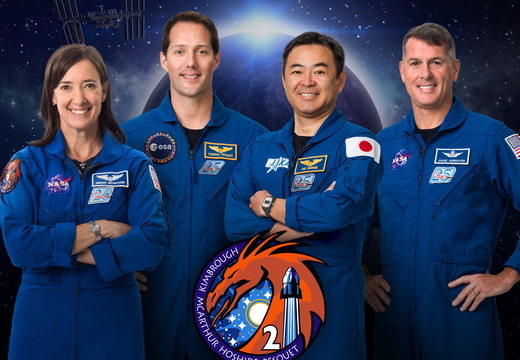
CREW-2
Mission Objective
NASA's SpaceX Crew-2 mission aimed to transport four astronauts to the International Space Station (ISS) for a long-duration mission focused on scientific research, technology demonstrations, and international cooperation. The mission sought to maintain a continuous human presence aboard the ISS and advance various microgravity studies.
All mission objectives were successfully achieved, with the Crew Dragon spacecraft demonstrating reliable performance in navigation, environmental control, and communication systems throughout the mission.
Mission Highlights
Crew-2 launched from Kennedy Space Center's Launch Complex 39A on April 23, 2021, at 5:49 a.m. EDT. The Falcon 9 rocket performed nominally, and the first stage successfully landed on the drone ship *Of Course I Still Love You* in the Atlantic Ocean.
Following stage separation, the Crew Dragon capsule *Endeavour* (C206) executed a series of maneuvers to autonomously dock with the ISS's Harmony module on April 24, 2021, at approximately 5:10 a.m. EDT.
During their 199-day mission aboard the ISS, the Crew-2 astronauts conducted over 200 scientific experiments and technology demonstrations, contributing to advancements in biotechnology, physical sciences, and Earth observation. The crew also performed station maintenance, including hardware upgrades and system checks to ensure optimal performance.
After completing their mission, Crew-2 undocked from the ISS on November 8, 2021, and safely splashed down in the Gulf of Mexico off the coast of Florida on November 9, 2021, at 10:33 p.m. EST. Recovery operations were executed smoothly, marking the successful conclusion of the mission.
Crew
Shane Kimbrough, Commander (NASA)
Megan McArthur, Pilot (NASA)
Akihiko Hoshide, Mission Specialist (JAXA)
Thomas Pesquet, Mission Specialist (ESA)
Payload
Crew Dragon *Endeavour* (C206)
Cargo: Scientific equipment, ISS maintenance hardware, and crew provisions
Prelaunch Milestones
03/01/21 – Crew Dragon *Endeavour* arrives at Kennedy Space Center
03/15/21 – Falcon 9 rocket integration complete
03/25/21 – Flight readiness review
04/20/21 – Static fire test completed
Launch
April 23, 2021; 5:49 a.m. EDT
Launch Pad 39A
Falcon 9 Block 5
Crew Dragon *Endeavour*
Firing Room 4
Orbit
Altitude: ~250 miles (ISS orbit)
Inclination: 51.6 degrees
Duration: 199 days
Distance: ~84 million miles
Landing
November 9, 2021; 10:33 p.m. EST
Gulf of Mexico, near Florida
Recovery Ship: *Shannon* (SpaceX)
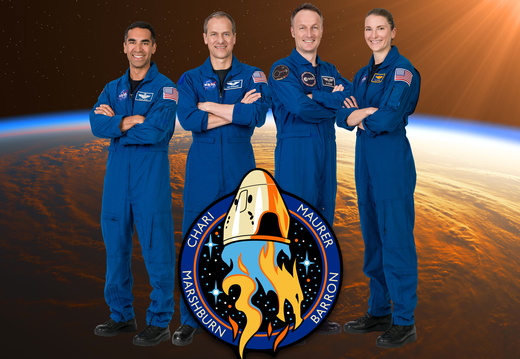
CREW-3
Mission Objective
NASA's SpaceX Crew-3 mission aimed to transport four astronauts to the International Space Station (ISS) for an extended stay, focusing on scientific research, technology demonstrations, and international cooperation. The mission sought to ensure continuous human presence aboard the ISS and advance various microgravity studies.
All mission objectives were successfully achieved, with the Crew Dragon spacecraft demonstrating reliable performance in navigation, environmental control, and communication systems throughout the mission.
Mission Highlights
Crew-3 launched from Kennedy Space Center's Launch Complex 39A on November 10, 2021, at 9:03 p.m. EST. The Falcon 9 rocket performed nominally, and the first stage successfully landed on the drone ship *A Shortfall of Gravitas* in the Atlantic Ocean.
Following stage separation, the Crew Dragon capsule *Endurance* (C210) executed a series of maneuvers to autonomously dock with the ISS's Harmony module on November 11, 2021, at approximately 6:32 p.m. EST.
During their 177-day mission aboard the ISS, the Crew-3 astronauts conducted over 200 scientific experiments and technology demonstrations, contributing to advancements in biotechnology, physical sciences, and Earth observation. The crew also performed station maintenance, including hardware upgrades and system checks to ensure optimal performance.
After completing their mission, Crew-3 undocked from the ISS on May 5, 2022, and safely splashed down in the Gulf of Mexico off the coast of Florida on May 6, 2022, at 12:43 a.m. EST. Recovery operations were executed smoothly, marking the successful conclusion of the mission.
Crew
Raja Chari, Commander (NASA)
Thomas Marshburn, Pilot (NASA)
Kayla Barron, Mission Specialist (NASA)
Matthias Maurer, Mission Specialist (ESA)
Payload
Crew Dragon *Endurance* (C210)
Cargo: Scientific equipment, ISS maintenance hardware, and crew provisions
Prelaunch Milestones
10/01/21 – Crew Dragon *Endurance* arrives at Kennedy Space Center
10/15/21 – Falcon 9 rocket integration complete
10/25/21 – Flight readiness review
11/05/21 – Static fire test completed
Launch
November 10, 2021; 9:03 p.m. EST
Launch Pad 39A
Falcon 9 Block 5
Crew Dragon *Endurance*
Firing Room 4
Orbit
Altitude: ~250 miles (ISS orbit)
Inclination: 51.6 degrees
Duration: 177 days
Distance: ~71 million miles
Landing
May 6, 2022; 12:43 a.m. EST
Gulf of Mexico, near Florida
Recovery Ship: *Shannon* (SpaceX)
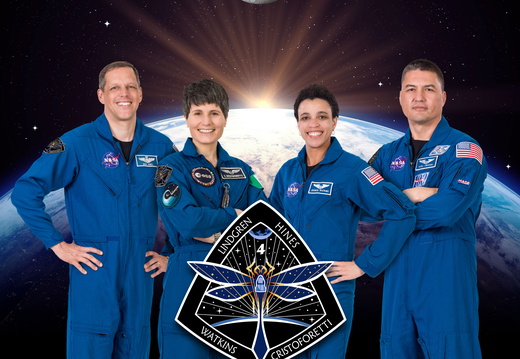
CREW-4
Mission Objective
NASA's SpaceX Crew-4 mission aimed to transport four astronauts to the International Space Station (ISS) for a long-duration stay focused on scientific research, technology demonstrations, and international cooperation. The mission sought to maintain a continuous human presence aboard the ISS and advance various microgravity studies.
All mission objectives were successfully achieved, with the Crew Dragon spacecraft demonstrating reliable performance in navigation, environmental control, and communication systems throughout the mission.
Mission Highlights
Crew-4 launched from Kennedy Space Center's Launch Complex 39A on April 27, 2022, at 3:52 a.m. EDT. The Falcon 9 rocket performed nominally, and the first stage successfully landed on the drone ship *A Shortfall of Gravitas* in the Atlantic Ocean.
Following stage separation, the Crew Dragon capsule *Freedom* (C212) executed a series of maneuvers to autonomously dock with the ISS's Harmony module on April 27, 2022, at approximately 7:37 p.m. EDT.
During their 170-day mission aboard the ISS, the Crew-4 astronauts conducted over 200 scientific experiments and technology demonstrations, contributing to advancements in materials science, health technologies, and plant science to prepare for human exploration beyond low-Earth orbit and benefit life on Earth. The crew also performed station maintenance, including hardware upgrades and system checks to ensure optimal performance.
After completing their mission, Crew-4 undocked from the ISS on October 14, 2022, and safely splashed down in the Atlantic Ocean off the coast of Florida on October 14, 2022, at 4:55 p.m. EDT. Recovery operations were executed smoothly, marking the successful conclusion of the mission.
Crew
Kjell Lindgren, Commander (NASA)
Robert Hines, Pilot (NASA)
Jessica Watkins, Mission Specialist (NASA)
Samantha Cristoforetti, Mission Specialist (ESA)
Payload
Crew Dragon *Freedom* (C212)
Cargo: Scientific equipment, ISS maintenance hardware, and crew provisions
Prelaunch Milestones
03/01/22 – Crew Dragon *Freedom* arrives at Kennedy Space Center
03/15/22 – Falcon 9 rocket integration complete
03/25/22 – Flight readiness review
04/20/22 – Static fire test completed
Launch
April 27, 2022; 3:52 a.m. EDT
Launch Pad 39A
Falcon 9 Block 5
Crew Dragon *Freedom*
Firing Room 4
Orbit
Altitude: ~250 miles (ISS orbit)
Inclination: 51.6 degrees
Duration: 170 days
Distance: ~68 million miles
Landing
October 14, 2022; 4:55 p.m. EDT
Atlantic Ocean, near Florida
Recovery Ship: *Shannon* (SpaceX)
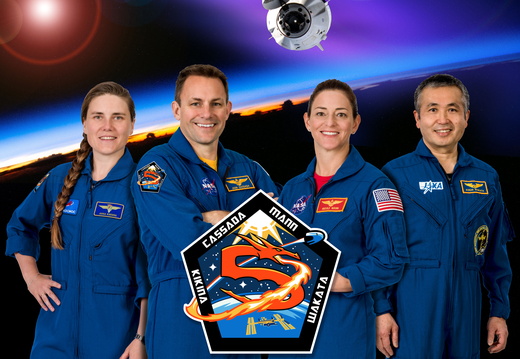
CREW-5
Mission Objective
NASA's SpaceX Crew-5 mission aimed to transport four astronauts to the International Space Station (ISS) for an extended stay, focusing on scientific research, technology demonstrations, and international cooperation. The mission sought to ensure continuous human presence aboard the ISS and advance various microgravity studies.
All mission objectives were successfully achieved, with the Crew Dragon spacecraft demonstrating reliable performance in navigation, environmental control, and communication systems throughout the mission.
Mission Highlights
Crew-5 launched from Kennedy Space Center's Launch Complex 39A on October 5, 2022, at 12:00 p.m. EDT. The Falcon 9 rocket performed nominally, and the first stage successfully landed on the drone ship *Just Read the Instructions* in the Atlantic Ocean.
Following stage separation, the Crew Dragon capsule *Endurance* (C210) executed a series of maneuvers to autonomously dock with the ISS's Harmony module on October 6, 2022, at approximately 5:01 p.m. EDT.
During their 157-day mission aboard the ISS, the Crew-5 astronauts conducted over 200 scientific experiments and technology demonstrations, contributing to advancements in biotechnology, physical sciences, and Earth observation. The crew also performed station maintenance, including hardware upgrades and system checks to ensure optimal performance.
After completing their mission, Crew-5 undocked from the ISS on March 11, 2023, and safely splashed down in the Gulf of Mexico off the coast of Florida on March 12, 2023, at 9:02 p.m. EST. Recovery operations were executed smoothly, marking the successful conclusion of the mission.
Crew
Nicole Mann, Commander (NASA)
Josh Cassada, Pilot (NASA)
Koichi Wakata, Mission Specialist (JAXA)
Anna Kikina, Mission Specialist (Roscosmos)
Payload
Crew Dragon *Endurance* (C210)
Cargo: Scientific equipment, ISS maintenance hardware, and crew provisions
Prelaunch Milestones
09/01/22 – Crew Dragon *Endurance* arrives at Kennedy Space Center
09/15/22 – Falcon 9 rocket integration complete
09/27/22 – Flight readiness review
10/01/22 – Static fire test completed
Launch
October 5, 2022; 12:00 p.m. EDT
Launch Pad 39A
Falcon 9 Block 5
Crew Dragon *Endurance*
Firing Room 4
Orbit
Altitude: ~250 miles (ISS orbit)
Inclination: 51.6 degrees
Duration: 157 days
Distance: ~63 million miles
Landing
March 12, 2023; 9:02 p.m. EST
Gulf of Mexico, near Florida
Recovery Ship: *Shannon* (SpaceX)
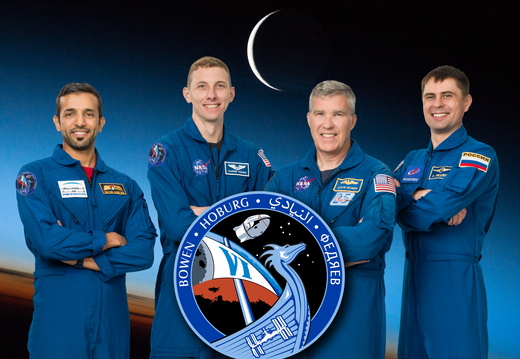
CREW-6
Mission Objective
NASA's SpaceX Crew-6 mission aimed to transport four astronauts to the International Space Station (ISS) for an extended stay, focusing on scientific research, technology demonstrations, and international cooperation. The mission sought to ensure continuous human presence aboard the ISS and advance various microgravity studies.
All mission objectives were successfully achieved, with the Crew Dragon spacecraft demonstrating reliable performance in navigation, environmental control, and communication systems throughout the mission.
Mission Highlights
Crew-6 launched from Kennedy Space Center's Launch Complex 39A on March 2, 2023, at 12:34 a.m. EST. The Falcon 9 rocket performed nominally, and the first stage successfully landed on the drone ship *Just Read the Instructions* in the Atlantic Ocean.
Following stage separation, the Crew Dragon capsule *Endeavour* (C206) executed a series of maneuvers to autonomously dock with the ISS's Harmony module on March 3, 2023, at approximately 1:40 a.m. EST.
During their 186-day mission aboard the ISS, the Crew-6 astronauts conducted over 200 scientific experiments and technology demonstrations, contributing to advancements in biotechnology, physical sciences, and Earth observation. The crew also performed station maintenance, including hardware upgrades and system checks to ensure optimal performance.
After completing their mission, Crew-6 undocked from the ISS on September 3, 2023, and safely splashed down in the Atlantic Ocean off the coast of Jacksonville, Florida, on September 4, 2023, at 12:17 a.m. EST. Recovery operations were executed smoothly, marking the successful conclusion of the mission.
Crew
Stephen Bowen, Commander (NASA)
Warren "Woody" Hoburg, Pilot (NASA)
Sultan Al Neyadi, Mission Specialist (UAE)
Andrey Fedyaev, Mission Specialist (Roscosmos)
Payload
Crew Dragon *Endeavour* (C206)
Cargo: Scientific equipment, ISS maintenance hardware, and crew provisions
Prelaunch Milestones
01/30/23 – Crew Dragon *Endeavour* arrives at Kennedy Space Center
02/15/23 – Falcon 9 rocket integration complete
02/24/23 – Flight readiness review
03/01/23 – Static fire test completed
Launch
March 2, 2023; 12:34 a.m. EST
Launch Pad 39A
Falcon 9 Block 5
Crew Dragon *Endeavour*
Firing Room 4
Orbit
Altitude: ~250 miles (ISS orbit)
Inclination: 51.6 degrees
Duration: 186 days
Distance: ~74 million miles
Landing
September 4, 2023; 12:17 a.m. EST
Atlantic Ocean, near Jacksonville, Florida
Recovery Ship: *Shannon* (SpaceX)
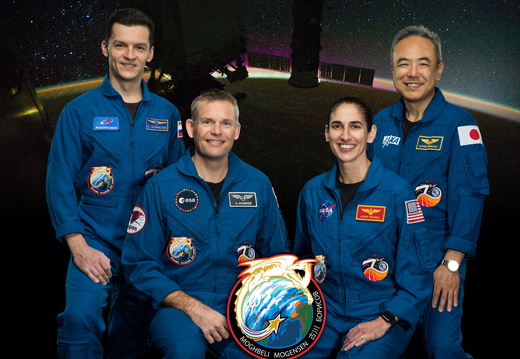
CREW-7
Mission Objective
NASA's SpaceX Crew-7 mission aimed to transport four international astronauts to the International Space Station (ISS) for a long-duration mission focused on scientific research, technology demonstrations, and station maintenance. The mission emphasized international cooperation and the continuous human presence aboard the ISS.
All mission objectives were successfully accomplished, with the Crew Dragon spacecraft performing optimally throughout the mission.
Mission Highlights
Crew-7 launched from Kennedy Space Center's Launch Complex 39A on August 26, 2023, at 3:27 a.m. EDT. The Falcon 9 rocket executed a nominal ascent, and the first stage successfully landed on the drone ship *A Shortfall of Gravitas* in the Atlantic Ocean.
The Crew Dragon capsule *Endurance* (C210) separated from the second stage and performed a series of maneuvers to autonomously dock with the ISS's Harmony module on August 27, 2023, at approximately 9:16 a.m. EDT.
During their 199-day mission aboard the ISS, the Crew-7 astronauts participated in a wide range of scientific experiments and technology demonstrations, contributing to advancements in various fields. The crew also conducted station maintenance and supported the arrival and departure of multiple visiting vehicles.
After completing their mission, Crew-7 undocked from the ISS on March 11, 2024, and safely splashed down off the coast of Florida on March 12, 2024, at approximately 5:47 a.m. EDT. Recovery operations were conducted successfully, marking the end of the mission.
Crew
Jasmin Moghbeli, Commander (NASA)
Andreas Mogensen, Pilot (ESA)
Satoshi Furukawa, Mission Specialist (JAXA)
Konstantin Borisov, Mission Specialist (Roscosmos)
Payload
Crew Dragon *Endurance* (C210)
Cargo: Scientific experiments, maintenance tools, and crew provisions
Prelaunch Milestones
06/26/23 – Crew Dragon *Endurance* arrives at Kennedy Space Center
07/20/23 – Falcon 9 rocket stages arrive at Cape Canaveral
08/10/23 – Crew arrival at Kennedy Space Center
08/21/23 – Integrated dry dress rehearsal
08/24/23 – Static fire test completed
Launch
August 26, 2023; 3:27 a.m. EDT
Launch Pad 39A
Falcon 9 Block 5
Crew Dragon *Endurance* (C210)
Firing Room 4
Orbit
Altitude: ~250 miles (ISS orbit)
Inclination: 51.6 degrees
Duration: 199 days
Distance: ~86 million miles
Landing
March 12, 2024; ~5:47 a.m. EDT
Atlantic Ocean, near Florida
Recovery Ship: *Shannon* (SpaceX)
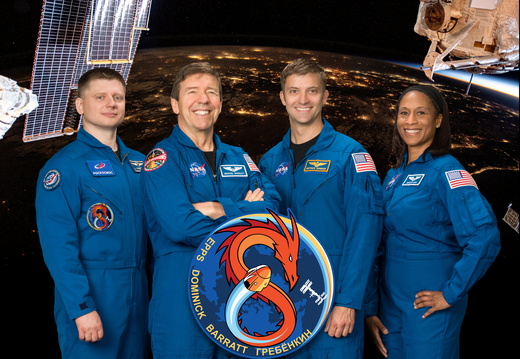
CREW-8
Mission Objective
NASA's SpaceX Crew-8 mission aimed to transport four astronauts to the International Space Station (ISS) for an extended stay focused on scientific research, station maintenance, and international collaboration. The mission sought to ensure continuous human presence aboard the ISS and advance various microgravity studies.
All mission objectives were successfully achieved, with the Crew Dragon spacecraft demonstrating reliable performance in navigation, environmental control, and communication systems throughout the mission.
Mission Highlights
Crew-8 launched from Kennedy Space Center's Launch Complex 39A on March 3, 2024, at 10:53 p.m. EST. The Falcon 9 rocket performed nominally, and the first stage successfully landed on the drone ship *Just Read the Instructions* in the Atlantic Ocean.
Following stage separation, the Crew Dragon capsule *Endeavour* (C206) executed a series of maneuvers to autonomously dock with the ISS's Harmony module on March 5, 2024, at approximately 2:28 a.m. EST.
During their 232-day mission aboard the ISS, the Crew-8 astronauts conducted over 200 scientific experiments and technology demonstrations, contributing to advancements in biotechnology, physical sciences, and Earth observation. The crew also performed station maintenance, including hardware upgrades and system checks to ensure optimal performance.
After completing their mission, Crew-8 undocked from the ISS on October 23, 2024, and safely splashed down in the Gulf of Mexico off the coast of Pensacola, Florida, on October 25, 2024, at 3:29 a.m. EST. Recovery operations were executed smoothly, marking the successful conclusion of the mission.
Crew
Matthew Dominick, Commander (NASA)
Michael Barratt, Pilot (NASA)
Jeanette Epps, Mission Specialist (NASA)
Alexander Grebenkin, Mission Specialist (Roscosmos)
Payload
Crew Dragon *Endeavour* (C206)
Cargo: Scientific equipment, ISS maintenance hardware, and crew provisions
Prelaunch Milestones
01/15/24 – Crew Dragon *Endeavour* arrives at Kennedy Space Center
02/10/24 – Falcon 9 rocket integration complete
02/20/24 – Flight readiness review
02/28/24 – Static fire test completed
Launch
March 3, 2024; 10:53 p.m. EST
Launch Pad 39A
Falcon 9 Block 5
Crew Dragon *Endeavour* (C206)
Firing Room 4
Orbit
Altitude: ~250 miles (ISS orbit)
Inclination: 51.6 degrees
Duration: 232 days
Distance: ~97 million miles
Landing
October 25, 2024; 3:29 a.m. EST
Gulf of Mexico, near Pensacola, Florida
Recovery Ship: *Megan* (SpaceX)
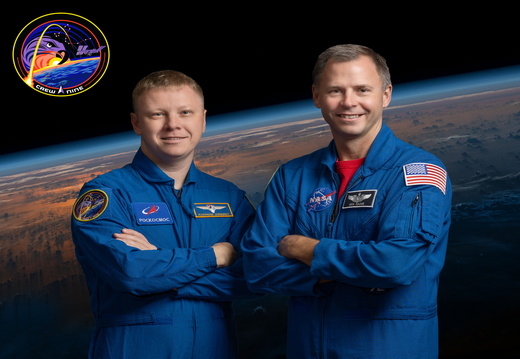
CREW-9
Mission Overview
NASA's SpaceX Crew-9 mission was the ninth operational crewed flight under the Commercial Crew Program, transporting astronauts to the International Space Station (ISS) for an extended mission. The mission aimed to continue the ISS's long-duration scientific research, support station maintenance, and demonstrate advancements in crew transportation technology.
Key Details
- Launch Date: September 28, 2024, 17:17:21 UTC
- Launch Vehicle: Falcon 9 Block 5
- Launch Site: Space Launch Complex 40 (SLC-40), Cape Canaveral Space Force Station, Florida, USA
- Docking Date: September 29, 2024, 21:30 UTC
- Undocking Date: March 18, 2025, 05:05 UTC
- Landing Date: March 18, 2025, 21:57:07 UTC
- Mission Duration: Approximately 172 days
- Crew Size: 2 astronauts (launch), 4 astronauts (return)
Crew
- Launch Crew:
- Commander: Nick Hague (NASA)
- Pilot: Aleksandr Gorbunov (Roscosmos)
- Return Crew:
- Commander: Nick Hague (NASA)
- Pilot: Aleksandr Gorbunov (Roscosmos)
- Mission Specialist: Barry E. Wilmore (NASA)
- Mission Specialist: Sunita Williams (NASA)
Mission Highlights
- Launch and Docking: The Falcon 9 successfully launched Crew-9 on September 28, 2024, from SLC-40 at Cape Canaveral Space Force Station. The Crew Dragon spacecraft autonomously docked with the ISS on September 29, 2024, facilitating a seamless crew transfer.
- On-Orbit Operations: The crew conducted a series of scientific experiments, technology demonstrations, and maintenance activities critical to the continued operation of the ISS.
- Spacewalks: Multiple extravehicular activities (EVAs) were performed to install new hardware and conduct repairs, contributing to the long-term sustainability of the ISS.
- Extended Mission Duration: Originally planned for a shorter stay, the mission was extended to approximately 172 days due to unforeseen circumstances, demonstrating the crew's adaptability and resilience.
- International Collaboration: The mission highlighted global partnerships in space exploration, with crew members from NASA and Roscosmos working together seamlessly.
- Return and Recovery: After completing their mission, the crew safely returned to Earth, with the Crew Dragon spacecraft splashing down in the Gulf of Mexico near Tallahassee, Florida, on March 18, 2025.
Outcomes
Crew-9 successfully demonstrated the reliability and safety of commercial crew transportation. The mission contributed valuable scientific data, supported ISS operations, and further advanced international cooperation in human spaceflight.
